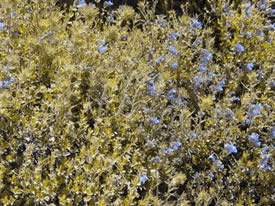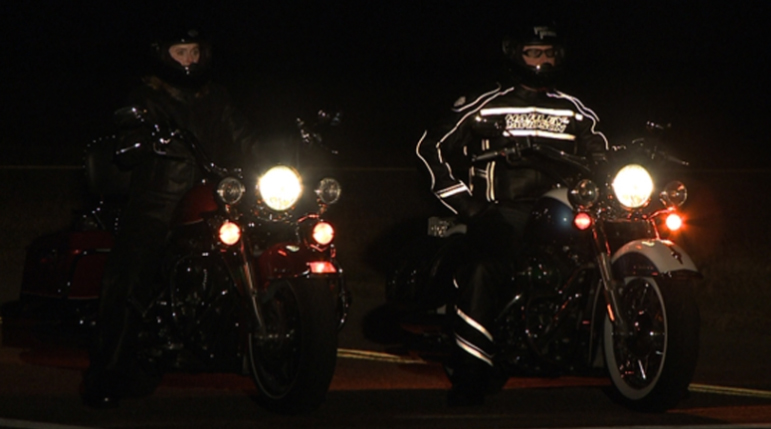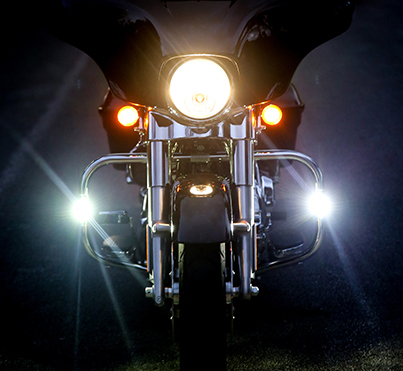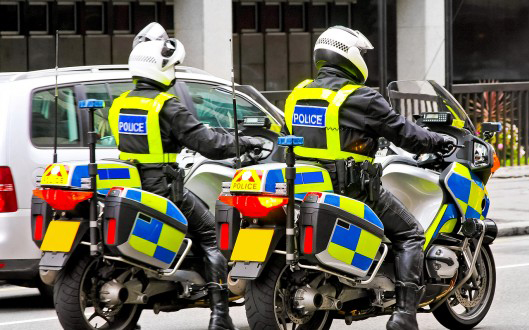Even if we don’t like wearing brightly colored apparel, as motorcyclists we understand that conspicuity increases the likelihood that drivers will see us in our increasingly cluttered and distraction-laden environment. But what is the best way to be seen? Is blaze orange better than high-viz yellow—or florescent pink? What about lights or reflective panels?
Numerous studies have been done since the early ‘80s that all come to the same conclusions:
- A conspicuous rider is more likely to be seen by drivers
- Contrast with the surrounding environment is the most important factor in conspicuity
- Bright colors are only effective during daylight hours
- Extra lights, especially those that create the effect of a larger object (placed on the lower fork or engine guard, handlebar or helmet), are a different color (such as yellow) or that modulate are most effective for conspicuity
Apparel
While we positively ooze sexiness when we’re draped over our motos wearing form-fitting black leather, it doesn’t do much for our conspicuity as we navigate roads full of distracted drivers who are all in a hurry to get somewhere.
So what’s the best way to outfit ourselves if we want to be seen? Science and anecdotal studies have shown us that there are three “best choice” options when it comes to color: florescent orange (also called International Blaze Orange or just Blaze Orange), florescent yellow/green (often called High-Viz) and florescent pink (Blaze Pink or Hot Pink).
- Highly visible in most environments
- Internationally recognized safety color
Blaze Orange – CONs
- Can blend into urban environments (think construction cones)
- Not ideal for riding in rural/wooded environments during autumn
- Highly visible in most environments
- Human eye is most sensitive to one specific shade of high-viz green
High-Viz Yellow/Green – CONs
- Can blend into rural/wooded environments
- Highly visible in all environments
- Does not blend into any background, unless you happen to be passing a big bush of bright pink flowers
Florescent Pink – CONs
- None…unless you just hate pink
A few more tips on color:
- Big blocks of solid color are better than small sections
- Color is most effective on the helmet (it’s high up, often visible above the rooflines of cars) and the arms/shoulders/legs (where it’s visible from both the front and sides, even with a top trunk or large windscreen that might obscure our torsos
- Your bike is a part of your conspicuity, especially if it’s covered in fairings; bright colors make a big difference
There is one glaring aspect of color conspicuity that is often overlooked, however: colorblindness.
It’s estimated that 8 percent of males and 0.5 percent of females have some form of colorblindness—that means that one out of every 12 guys you know is colorblind. The images below are examples of how the various forms of colorblindness affect they way colors appear.




Notice that for the first two examples (Protanope and Deutanope), the orange flowers totally disappear, while the pink flowers turn blue or lavender (but at least they’re distinguishable). For Tritanopes, meanwhile, both orange and pink flowers remain distinguishable from the background, although they look alike.
It’s worth noting that I’ve found several references where colorblind people remark that it’s easier for them to see florescent orange or yellow, but florescent pink is tougher.
It’s clear that we can’t rely strictly on color when it comes to conspicuity, but before we leave apparel let’s talk reflective panels. Most moto apparel incorporates reflective materials, but where is it most effective? Studies say the lower, the better.
Car headlights cast light ahead and towards the ground, so it’s ideal to have some reflectivity on your boots and lower legs. Cruiser riders, especially if your bike has saddlebags, are most vulnerable since you’re low to the ground and your lower legs could be obscured from the rear, so reflectivity above the waist is equally important. I like reflective panels at my waist (visible from the sides with my arms raised in riding position), shoulders and upper back.

Lights
Probably the most reliable means of being seen is through the use of lights. When commuting in daylight on our test bikes, I usually ride with the high beam on, especially in heavy traffic or in dense urban environments. Adding auxiliary driving lights is even better, however.
If possible, mount your lights on the lower fork tubes and/or engine guards—basically away from the headlight, creating a “triangle” effect that looks like neither car nor motorcycle. It’s the same principle as the color contrast—you want to stand out from your environment.

When choosing auxiliary lights, remember:
- A yellow or blue-ish light—anything different from your headlight color—adds to your conspicuity
- The smaller the lens size, the brighter a light will appear; for example, a light with a shallow 1-inch lens will appear brighter to a driver than a light with a deep 4-inch lens
- Laws vary by state, so check yours before purchasing; in some states modulating lights (which oscillate the intensity of your headlight from approximately 20 percent to 100 percent while you ride) are legal, in others they are not
Being visible from behind is just as important as the front, so the addition of an LED brake light bar is a great idea. I like AdMore Lighting’s Light Bar with “smart braking technology”; it incorporates an accelerometer that senses when you slow down without braking (such as when releasing the throttle or downshifting) and activates the Light Bar brake light.
The bottom line, however, is that in the end we are responsible for ourselves. Even with every safety measure in place, wearing a combination of blaze orange, high-viz yellow and hot pink, covered in reflective strips and with 6,000 lumens of light blasting from our bikes, we should still be ready to act and react to the constantly changing situation around us.
Have a “how to be seen” tip? Share it in the comment section below.



















fluorescent, not florescent.
“In some states modulating lights (which oscillate the intensity of your headlight from approximately 20 percent to 100 percent while you ride) are legal, in others they are not.”
This is wrong. Headlight modulators are federally regulated in both the US and Canada, and this federal regulation preempts any state law – basically, no state can enact legislation which overrides this federal regulation. As such, headlight modulators are legal in ALL states and ALL Canadian provinces.
You can see the applicable regulations here, as a printable PDF that you can use to inform any roadside traffic officer who may be uninformed:
http://goldwingdocs.com/Manuals.asp
A headlight modulator is legal because one beam (typically low beam) stays on all the time, and the other pulsates on and off. They are legal by federal statute (don’t read it… It’ll bore you to death).
A “Wig wag” device pulsates between the headlights on a vehicle. One side is on while the other is off. You see these on emergency vehicles, the flashing designed to pull in the eye of drivers. They are only allowed on emergency vehicles (which can include personal vehicles of emergency responders in many states)
Years ago, when I was a fire fighter, Mercedes Benz conducted a test, the results of which showed that hi-viz yellow was the color most easily seen under all lighting conditions. White was second. I don’t remember where orange and pink came in on the list. Red was about as difficult to see at night as black, blue and grey. Therefore, many fire departments repainted their vehicles in the hi-viz yellow/green, as did my department. However, in the ensuing years a lot of departments repainted their trucks red. Why? They found that many people didn’t recognize a yellow/green vehicle as a fire truck or rescue vehicle. After all: fire trucks are red, right? Everybody knows that!
Right. And modulators do not “oscillate from 20 to 100%”. A Modulator, well legal devices, (typically) leave the low beam on continuously and pulsate the high beam on and off… You can research and read the government mumbo jumbo.
If a headlight pulsates on and off it is known as a wig wag (brand name), and it’s what you see on emergency vehicles where the headlights turn on and off (one is on while one is off). Those are illegal in all states except on emergency vehicles (which includes emergency responder personal vehicle in some states)
It’s interesting that Police bikes are covered in hi-viz yellow and blue squares that appear to be very visible, yet in reality they break up the outline of the bike making it harder to see (or identify as a police bike). This is the same principle used on ships during the second world war.
A friend of mine has an ex-police bike (FJR1300) that’s had all of the hi-viz removed and is plain white, which stands out way more.